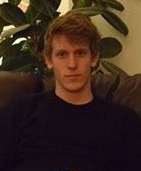
Parker is currently doing graduate work at University College London.
Students and their capstone projects
Class of 2017
Parker Heyl
 |
Parker, a mechanical engineering major, designed and built a unique instrument called the "Electric Slackline." It used an actual slackline—a tensioned band—as a sound source, amplifying the natural sound of one or two people standing or walking on the band, and giving the users controls to modulate the timbre of the sound in real time. A video demonstration of the project can be found at https://vimeo.com/195407591. Parker is currently doing graduate work at University College London. |
Eric Hochwald
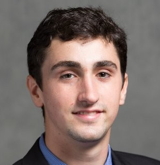 |
Eric, a computer science major, wrote, recorded, mixed, produced, and played multiple instruments (primarily drums) on an album of eight songs with his band, Space Ink. He is working as a programmer at InterSystems Corporation in Cambridge, MA. |
Jacob Katsiaficas
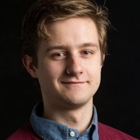 |
Jake, a computer science major, developed "ModVerb," a modulated reverb processor in the form of a Rack Extension for Propellerhead Software's Reason. He is now a software engineer for Wayfair. |
Will Luna
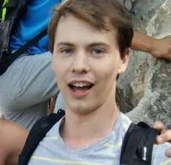 |
Will was an interdisciplinary studies major, combining computer science, music, and cognitive brain science. His senior thesis tested how different types of background music affect performance while playing a game that tests basic mathematical reasoning; whether making the music "dynamic," so that it changes with the performance of the player, can improve the performance. Will is now an educational consultant at Elite Scholars of China in Beijing. |
Rachel Marison
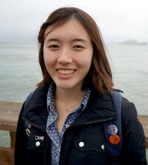 |
Rachel, a computer science major, designed a Web app called "Image Vocalization," that creates melodies out of user-supplied or designed images. She is now a software engineer at IBM in Cambridge, MA. |
Jack Vallerie
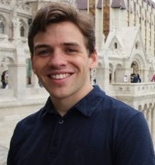 |
Jack, a computer science major, wrote, recorded, mixed, sang, and played drums, piano, and synthesizers on a four-song EP. He is now an IT technician at Clover Food Lab. |
Greg Warns
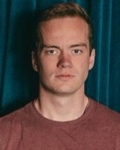 |
Greg, an Electrical Engineering major, worked with a group of four other students to create "Triphonic", an interactive listening experience that places a listener at the center of a virtual soundscape composed of musical instruments. The program uses head tracking and spatial audio algorithm techniques that have been developed over the past few years alongside the rising interest in virtual reality. Greg is now a product engineer with Bambu Tech, working on DSP applications for consumer audio products. |
Class of 2016
Thomas Colgrove
 |
Tom's senior project, under the direction of Psychology Professor Ani Patel, developed and studied technology that employs musical training to improve speech perception in people with cochlear implants. Their paper was presented at the International Conference on Music Perception & Cognition in July, 2016. Tom is now a software engineer at Cimpress. |
Joseph Palandrani
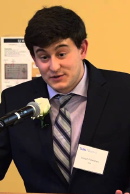 |
Joe, an anthropology major, interned with XIX Acoustics, a Medford-based firm that specializes in the design and treatment of spaces with widely different acoustical needs, including music practice rooms, churches, and recording studios. Joe also created an outline and technical details for a musical composition using loudspeakers, resonators, and the acoustic characteristics of a classroom, called Sonata for Resonators. Joe currently works as a Litigation Paralegal in New York City. |
Class of 2015
Ruben Sonz-Barnes
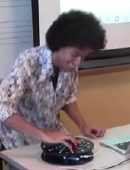 |
Ruben's final project for the Music Engineering minor was composition called Harmonic Serial, which was based on the natural mathematical harmonic series. He used the series both for creating movable just intonation tunings for his computer-based instruments, and for creating the structure of the piece, which was in five movements. The work used both live and pre-recorded elements, using both electronic and acoustic sources, including a cello trio. His software instruments were created in Max/MSP, and the work included a section that featured the Spiral of Fifths, an instrument he created with his team in Music 66—Electronic Musical Instrument Design in 2014, and modified (and made wireless) in 2015. The Spiral of Fifths was a semi-finalist in the renowned Guthman Musical Instrument Competition at Georgia Tech for 2016. Ruben currently works as a product specialist demonstrator for ROLI, makers of innovative musical instruments. |
Michael Nuzzolo
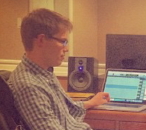 |
Michael worked with a songwriter named Tim Gibson to record, mix, and produce a full-length album of original music called The Place We Haven't Seen, in his own home studio. He documented the project extensively, discussing the technical, musical, and logistical issues involved in producing a professional-sounding album on an extremely low budget. He is vice-president of event management at Boston AV Productions, and is developing iOS apps for Sonos. |
Kurt Oleson
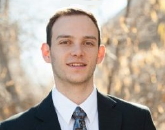 |
Kurt's senior honors thesis, under the supervision of Dr. Lehrman, Prof. Robert Jacob (computer science), and Prof. Ani Patel (psychology) was called An Adaptive fNIRS-based BCI for Learning Music on the Piano. The study tested a method of teaching piano in which the student was taken through increasingly advanced exercises, with the pace of change based on measurements of the blood flow in a specific area of the brain that corresponds to the difficulty of a task. Kurt interned at TimeWarp Technologies, makers of educational music software, and is now a developer at Custom Channels of Boulder, Colorado. |
Scott Jacobson
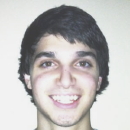 |
Scott's senior project was a self-produced album of original music, in a studio that he built by himself in his apartment. His documentation included a detailed diary of the studio's construction, and the formidable acoustic, technical, and logistical problems he addresed. Scott is a developer at Eko, producers of interactive video storytelling. |
Class of 2014
Shayne Hubbard, Brian McLaughlin, and Josh Rapp
 |
Shayne, Brian, and Josh collaborated on yet another piano-based project, using force-sensing resistors (FSRs) to sense and measure the velocity of the hammers, to generate MIDI data from a piano action, under the direction of Prof. Jeff Hopwood. Jumbo magazine did an article on the trio: click here or here. |
Liam Cassidy
 |
Liam's senior project was developing a live music-performance system based on Microsoft's Kinect technology and using Max/MSP and Ableton Live. His video of the project is here. Liam is a carrier analyst at Thinkingphones. |
Neil Foxman
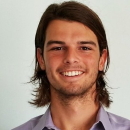 |
Neil's senior project was an automatic drum-tuning system that combined mechanical engineering with pitch analysis. He is a mechanical engineer at Simplexity Product Development in San Diego. |
Class of 2013
Alex Chan
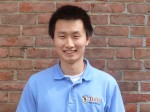 |
Alex graduated early
in December 2012 with the Music Engineering Minor in Acoustic Instrument
Design. His team, which included Emmanuel Runes and Chris Smith,
created a ukelele out of carbon fiber, specifying all of the design
and manufacturing components. The work continued in Spring 2013.
Their preliminary report is here. After two years at bicycle design company Cantabrigian Mechanics, Alex is now a test engineer at Google[x] Makani Power, working with airborne wind turbines. |
Thomas Cahill
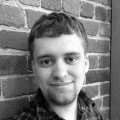 |
Tom continued the work of Calvin, Erik, and Charlie (below) and perfected the electro-optical piano-keyboard scanning system, achieving effectively zero latency. A video of his project is here. He did not formally complete the minor, but served the program with distinctions in a number of capacities. Tom is working for Apcera, a Bay Area company developing n operating system for the hybrid cloud. |
Ben Ewing
 |
Ben produced an EP of original songs for his senior project, under the supervision of John McCann, director of the Tufts Wind Ensemble. He is now Community Manager at GrabCAD, makers of collaborative software for industrial designers. |
Class of 2012
Michael Siegel
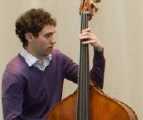 |
Mike created a plugin
for professional audio platforms to standardize headphone listening,
to compensate for amplitude, phase, and frequency-response differences
among many popular models of headphones. A video of his project is here.
Mike worked as a DSP engineer at Bose Corporation for over two years and is now an embedded systems engineer at Grove Labs, developing new technologies for home agriculture. |
Calvin Hopkins, Erik Formella, and Charlie Powell
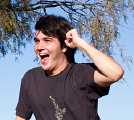 |
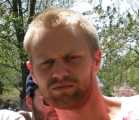 |
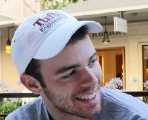 |
Calvin, Erik, and
Charlie worked
on an electro-optical piano-keyboard scanning system to reduce latency
and jitter, and thereby improve its performance as a MIDI controller.
Details of their project are here, and a video is here. Calvin and Charlie are now both Software Development Test Engineers at Microsoft. Erik has worked at Zigelbaum + Coelho and at The Echo Nest and is currently a software engineer at UberCab.com. |
Class of 2011, the first to graduate Tufts with the new Music Engineering minor.
Jonathan Evans and Andrew Kim
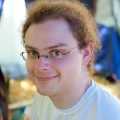 |
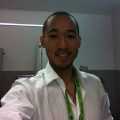 |
Along with two other
electrical engineers, Jonathan and Andrew designed and built a modular
Class-H power amplifier for audio signals. By using a digital signal
processor to read the incoming audio signal amplitude and modulate the
power supply rails, the amplifier achieves higher efficiency than the
standalone Class-AB circuit upon which it is based. The amplifier can
be expanded to higher power applications by replacing the output stage,
power supply, or both, while maintaining the same DSP hardware and software. Jon is now a hardware engineer at Olympus IMS. Andrew is an electrical engineer in audio at Corsair Memory. |
Jason (Jay) Clark
 |
Jay developed
two applications for the Apple iPad. The first is a "mobile mixing
station"
for Distler Hall.
Using Tufts' wireless network, MIDI information from a mixing
interface on the iPad can be sent to a mixer in the control room, allowing
an engineer to mix the sound from anywhere in the audience. The second is a music-composition tool exploring some of the gestural capabilities of the iPad: buttons, sliders, swiping, pinching, drawing, shaking, rotating, etc. Each gesture will have some musical significance, and a performance can be built and manipulated. Jay got his Master's degree at the Georgia Tech Center for Music Technology and is now a mobile software engineer with NCR, as well as a renowned Ultimate Frisbee player and video producer. |
Karen Wickert
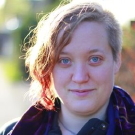 |
Karen built
an Electronic Drum Controller: A MIDI instrument in which a variety of
sensors communicate with an external MIDI interface, such as a computer,
via an Arduino microcontroller. The goal was to have an instrument
which accurately outputs djembe sounds when played naturally as a djembe
(a traditional African hand drum). To accomplish this, sensor data is
manipulated via an algorithm which outputs MIDI to a synthesizer for
selective djembe sample playback. Karen is now a mechanical engineer with Foliage. |
Nicholas Gang
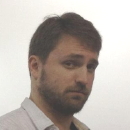 |
For his senior project, Nick worked with Kurzweil
Music Systems to develop an alternative controller for
their new flagship workstation. The controller, named the "Hot
Hand," is an ergonomically
designed bed for the left hand capable of sensing linear position and force
simultaneously for three different fingers and well as a thumb rocker.
It can control parameters of Kurzweil's V.A.S.T. synths and DSP effects
in several programmable banks that can constantly be cycled through. The goal of the project was to create an intuitive human interface, built into an actual keyboard controller, designed specifically for live performance. The ability to quickly cycle through banks of controller destinations would allow the user to set up an endless amount of controller "scenes" in the style of Ableton Live, and call them up quickly. After graduation, Nick worked for several years at Kurzweil's research facility, the Young Chang R&D Institute, and is now pursuing graduate studies at Stanford University's CCRMA. |